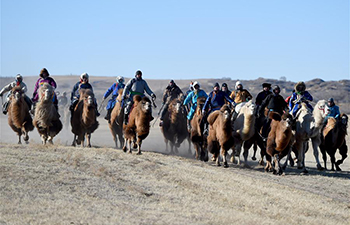LOS ANGELES, Jan. 2 (Xinhua) -- Scientists from NASA's New Horizons mission on Wednesday released the first detailed images of the most distant object ever explored - the Kuiper Belt object nicknamed Ultima Thule, unveiling the very first stages of solar system's history.
New Horizons performed the farthest flyby in history at 12:33 a.m. EST (0533 GMT) on New Year's Day, as it approached Ultima Thule within 2,200 miles (about 3,540 km) of the surface at a velocity of 31,500 miles (about 50,694 km) per hour.
The new images -- taken from as close as 17,000 miles (about 27,000 km) on approach -- revealed Ultima Thule as a "contact binary," consisting of two connected spheres, said NASA.
End to end, the world measures 19 miles (about 31 km) in length. The team has dubbed the larger sphere "Ultima" (12 miles/19 km across) and the smaller sphere "Thule" (9 miles/14 km across).
Ultima and Thule were once separate, free-flying objects. They coalesced long ago, just after the solar system's birth, according to the mission team.
This union was not violent. The two bodies came together at about walking speed, in a meetup more akin to a spacecraft docking than to a collision, said Jeff Moore, leader of New Horizons' geology and geophysics team.
The two spheres likely joined as early as 99 percent of the way back to the formation of the solar system, said the team.
The appearance of Ultima Thule, unlike anything human have seen before, illuminated the processes that built the planets four and a half billion years ago, said NASA.
"New Horizons is like a time machine, taking us back to the birth of the solar system. We are seeing a physical representation of the beginning of planetary formation, frozen in time," Moore said.
"Studying Ultima Thule is helping us understand how planets form, both those in our own solar system and those orbiting other stars in our galaxy," he said.
Data from the New Year's Day flyby will continue to arrive over the next weeks and months, with much higher resolution images yet to come, said NASA.
"In the coming months, New Horizons will transmit dozens of data sets to Earth, and we'll write new chapters in the story of Ultima Thule - and the solar system," said Helene Winters, New Horizons project manager.
Ultima Thule, at 4 billion miles (about 6.4 billion km) from the Sun and 1 billion miles (about 1.6 billion km) from Pluto, will be the most distant object ever directly explored, according to NASA.
The flyby of Ultima Thule was the first-ever exploration of small Kuiper Belt Objects, a disc-shaped region beyond Neptune that extends from about 30 to 55 astronomical units.
"This flyby is a historic achievement," said New Horizons Principal Investigator Alan Stern of the Southwest Research Institute in Boulder, Colorado.
"Never before has any spacecraft team tracked down such a small body at such high speed so far away in the abyss of space. New Horizons has set a new bar for state-of-the-art spacecraft navigation," he said.
The New Horizons mission, launched in January 2006, aims to understand worlds at the edge of our solar system by making the first reconnaissance of the dwarf planet Pluto, and by venturing deeper into the distant, mysterious Kuiper Belt -- a relic of solar system formation.
The Ultima Thule encounter, the most-distant planetary flyby in history, is the centerpiece of New Horizons' extended mission, which runs through 2021.
Stern said the spacecraft has enough power and fuel left to potentially perform a flyby of yet another distant object, if NASA ends up approving another mission extension.













